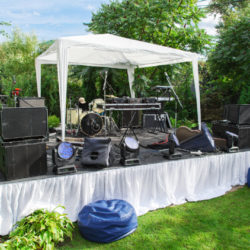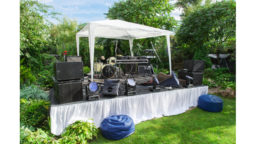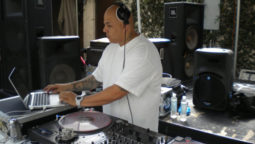Headphones, needles, audio interface, laptop and music…check. That’s all you really need in club land.
But what about the mobile side? Controller, mixer, power conditioner and/or voltage regulator, signal processor, wireless microphone, backup hard drive, XLR Cables, power and extension cords, speakers, subwoofers, extra speakers, speaker poles or tri-pods, digital recorder, A/V or gaffer’s tape, trussing, scrims, light fixtures, light stand, light controller, projector screens, tables, linens *gasps for air* and maybe a façade? Yes, all of these things are tools we mobile and wedding DJs use on a regular basis. Sometimes we use what’s minimally required for each job, but for the most part, having these tools in our inventory (or at least the ability to provide and use these tools for our clients) is essential.
First, we need a reliable music source. Traditionally, two turntables, two CD players or some sort of two-deck controller is what a DJ would use. Today, there are so many choices out there – so many brands to choose from. There is club standard gear and on the other end of the spectrum is entry-level DJ gear. Know where you are and what you’re capable of and start with a setup you are comfortable with. If you don’t have much money, acquire some used gear at a discount or get a credit card like I did and splurge! I’m very picky about what a good controller should do, what features my ideal controller would have and even what all the manufacturers are doing currently (and what they are ignoring).
My Standard Setup
This is what I typically pack into my DJ workstations (yes, I have multiple units). First, everything is loaded into a 19” workstation rack by SKB like this one. My instrument of choice for the mobile world (when I’m not using turntables or CDJs in a club) is the Denon DN-HD2500. I install a Denon DN-X500 mixer as well as a Shure SCM268 Microphone Mixer plugged into the main mic input on the Denon mixer. Alongside the mic mixer, I install my wireless mic receiver–a Shure PGX4, which has become my standard (I have over 12 PGX systems in my inventory). I also have a backlit keyboard, powered USB hub, Shure SM58 corded mic, a couple of hard drives with music on them, signal and power cables, headphones and even a phone charger loaded into my workstation–all plugged into a Monster Pro 2500 power conditioner. Some of my workstations have BBE Sonic maximizers for small sound quality adjustments. One of them even has a compressor/limiter and a while back, I used to have dual 15 band EQ’s in them. But because I have passive speakers that sound great, have awesome protection and DSP (Digital Signal Processing) built in, no need for the extra signal processors. I have everything I need in one case–all I have to do is plug the power and signal cables in and I’m up and running very quickly and after events, doesn’t take long to pack up.
Why You Need Multiple Setups
Moving gear during an event and having “music gaps” are decidedly not cool. I avoid this by having multiple sound systems for each area an event is taking place at. One venue I do weddings at has three areas: one for the ceremony, one for the cocktail hour and one for the meal and dancing. The last thing you want to do as a professional is tell your client that you have to break down and move your system two times during the event. I set up the ceremony and cocktail hour areas first, each with their own sound system and workstation. While cocktail hour is taking place, I move what’s used at the ceremony to the dinner and dancing area–so that as guests progress throughout the event, music is playing when they leave one area, and music is playing when they arrive to the next area. So having multiple setups can help immensely to make things go smoother for your clients and their guests. Not to mention, if something happens to your gear, you always have a backup plan onsite.
Odds & Ends
Here are some other critical things to be aware of. What if a videographer needs a feed from the “record out” on your mixer, even if it’s just a backup to his microphones? Easy. Get a 1/8” to RCA adapters hooked up to the mixer, both for a secondary input from an iPod or laptop and one for the record out. This is for a digital recorder or transmitter the videographer might be using (receiver on camera). I always keep a few spare power outlets available under my table in case someone needs power. I tape down all my cords for safety and appearance reasons. I also always try to have a couple of spare batteries in my pocket in case the batteries in microphones wear out during an event. A good thing to do is know how many hours your batteries last in your microphones, so that you can always make sure they are fresh and not going to go dead in the middle of something. Also, if someone else like a videographer is using wireless microphones, be sure to communicate with them about frequencies being used so there’s no overlap causing interference. Be sure to test your mics out when their mics are on to be extra careful.
We’ve covered most of the essentials. However, for aesthetic reasons, we sometimes need to bring our own tables, linens, scrims and facades to make our stuff look good. I typically request the client cover the linens and tables, so that I don’t impede the overall “look” of the event, but sometimes I do have to bring my own (I have plain white and black linens only). Sometimes we do extra things involving lighting or video for our clients, so just be prepared to have what’s needed to make it all happen.




Join the discussion
comments powered by Disqus